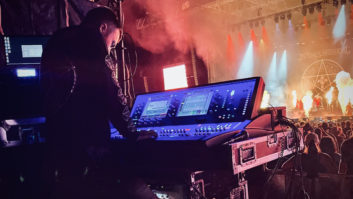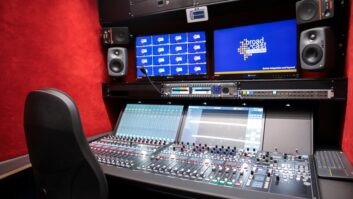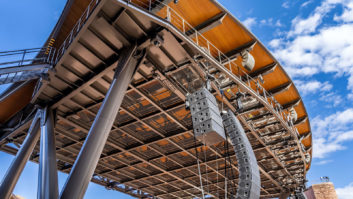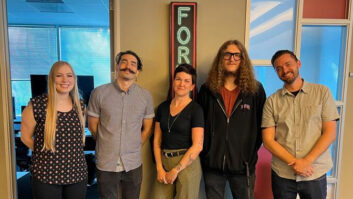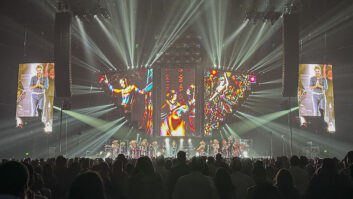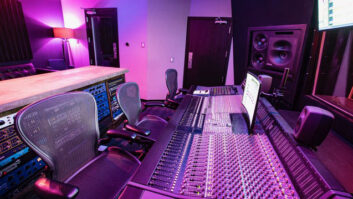Shania Twain is on the road with her first U.S. tour since 2004, carrying a sizable Meyer Sound Leo line array system supplied by VER Tour Sound.LOS ANGELES, CA—Shania Twain’s Rock This Country Tour, which launched in Seattle on June 5, was intended to be the Canadian country-pop singer’s last hurrah. But just days after PSN visited the production at the Staples Center in downtown Los Angeles, Twain revealed that she was extending her North America-only farewell jaunt to Europe and possibly beyond, and hopes to return to her Las Vegas residency soon.

Twain’s Shania: Still the One two-year run at The Colosseum at Caesars Palace, which ended in December, 2014, influenced some of the technical decisions on this latest production, which has audio provided by VER Tour Sound and is her first since the 2003/2004 Up! Tour. For instance, front-of-house engineer Nigel Green brought the same desk that he’d been using at Caesars Palace—an Avid D-Show with a sidecar—out on the road.
“It didn’t seem to make sense to change everything that was already programmed. There were new songs, but not all of it was new, so we stayed with the Avid,” he says.
Green is using the timecode that runs the show’s complex lighting and video production to automate various aspects of his audio mix. “I try to use it just to bring general scenes up,” he says, “but I program certain things: If something has to come up for a solo, I have those pre-programmed. All the original programming, whether something is compressed or EQ’d a certain way, was done in rehearsals. [Those channels] then go to the VCAs and I manually ride those, because it sounds different in every building. But it’s handy to have the timecode to switch the stuff so that I don’t have to think about it.”
Green has mixed Twain’s tours and broadcast specials since the beginning, and has also mixed Bruce Springsteen live. As he notes, in the studio, an engineer might spend hours programming faders. “It’s about trying to enhance the music, and I try to do that live. In an arena, to get the clarity, you really have to over-exaggerate some of the moves—I do, anyway.”
Unlike Green, monitor engineer Connie Fernstrom changed out his console for the tour. “When we were in Vegas, I had a [Yamaha PM]1D,” he reports. “This is my first tour with the [DiGiCo] SD5. It’s a really nice desk; I’m very pleased. It sounds great.” With such a complex show, Fernstrom is generating 30 sends to feed production personnel such as the pyro specialists as well as the musicians, all of whom are on in-ears.
The way that system engineer and crew chief Kennith “Kenny” Sellars has configured the P.A. to handle the time that Twain spends in front of the speakers also enhances Green’s mixing capabilities. “A saddle comes up out of the center of the thrust and brings her right out in front of the P.A., around and back in front of that P.A. [indicating the opposite hang], back to the middle and down,” explains Sellars. “Most people would send me left, right, sub and fill. Instead, I got Nigel to send me left, right, sub and vocal. There’s no vocal in the left/right buss.”
Twain continues to favor a wireless Sennheiser MD5235 vocal mic, custom finished in red, which she has used for years. Background vocals by her six-man, one-woman band are via DPA 4088F headsets.
The speaker system is all Meyer Sound. Each main left and right hang comprises 14 Leo boxes with four Lyon W cabinets—the 100-degree wide version—below. “Normally, the side hang—we’re only doing two of the three hangs today—has eight Leos with six Lyon Ns,” the 80-degree narrow version. “The rear hang, which is my side hang here, is 12 Lyon Wides,” he adds. The system is completed by Meyer 1100-LFC subs, typically including four per side flown in a cardioid configuration.
System engineer and crew chief Kennith “Kenny” Sellars (left) and Twain’s longtime studio and live engineer, Nigel Green, confer at the Avid Venue D-Show console during the tour’s stop at the Staples Center in Los Angeles. “The P.A. is broken out so that I have individual control of every box,” says Sellars. “I can take her vocal and turn it up and down per box as needed when she’s in front of it. Part of my night is spent chasing her around. I have her in the left bottom boxes, the right bottom boxes, left front fills and right front fills, on big faders.”

Such granular control is afforded through a dozen Meyer Sound Calisto DSP units. Sellars explains, “There are two master Calistos, AES in and out. One of them gets the left/right and the other gets sub/vocal, and there’s an output for each array. I have 10 non-AES Calistos, and two spares. They spit out analog to the boxes individually. Every slave Calisto gets left, right, sub and vocal, so that if I need to plug something else into a different one, I can. I don’t have to figure out cabling—everything goes everywhere.”
Sellars has also set up a Waves C3 multiband compressor plug-in on the D-Show for Green. “When she sings, it carves out the midrange, 800 to 2k, of the left and right mix,” explains Sellars, “so her vocal sits on top. She’s hot and loud and clear, and the band fills in around her.”
“I try to get the beginnings of songs loud and punchy, but I know I can’t keep it there because it will be too loud,” comments Green. “The drums will come in loud on a song and as soon as she comes in, I bring the general buss of the whole band down. The audience focuses on the voice and doesn’t even notice that the band has come down.”
Plus, he notes, “Having the stereo buss separate from the vocal means that I can EQ things and not worry. Say I wanted a bit more top in the mix; if the vocal was going there, it would change the sound of the mic, but the mic is going through its own processing.”
Unlike a record, a live mix is ephemeral, as Green notes: “The thing about the music is that it’s so well-arranged. So now it’s just about trying to deliver it. What I try and do is enhance the hooks and push those things up. People buy tickets, have a good time and that’s it; it’s gone. They’re not going to listen to it again.”
VER Tour Sound
Verrents.com
Meyer Sound Labs
Meyersound.com
Avid
Avid.com

